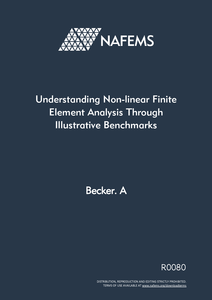| CHAPTER 1 - INTRODUCTION | 1 |
| 1.1 SCOPE AND LAYOUT OF THE BOOK | 1 |
| 1.2 CLASSIFICATION OF NON-LINEARITIES | 2 |
| 1.3 NON-LINEAR FE PROCEDURES | 7 |
| CHAPTER 2 - PLASTICITY (TIME-INDEPENDENT MATERIAL NON-LINEARITY) | 13 |
| 2.1 INTRODUCTION | 13 |
| 2.2 STRESS-STRAIN RELATIONSHIPS | 14 |
| 2.3 REVIEW OF ELASTO-PLASTICITY THEORY | 21 |
| 2.4 FUNDAMENTAL 2D PLASTICITY BENCHMARK | 31 |
| 2.5 3D PLASTICITY BENCHMARK | 39 |
| 2.6 KINEMATIC HARDENING BENCHMARK | 45 |
| 2.7 PRESSURISED CYLINDER PLASTICITY BENCHMARK | 51 |
| 2.8 CYCLIC PLASTICITY BENCHMARK | 57 |
| 2.9 RIGID PUNCH PLASTICITY BENCHMARK | 66 |
| CHAPTER 3 - CREEP (TIME-DEPENDENT MATERIAL NON-LINEARITY) | 71 |
| 3.1 INTRODUCTION | 71 |
| 3.2 REVIEW OF CREEP THEORY | 72 |
| 3.3 CONSTANT-LOAD CREEP BENCHMARKS | 83 |
| 3.4 STRESS RELAXATION CREEP BENCHMARKS | 87 |
| 3.5 VARIABLE-LOAD CREEP BENCHMARKS | 92 |
| 3.6 PRESSURISED CYLINDER CREEP BENCHMARK | 96 |
| 3.7 TORSIONAL CREEP BENCHMARK | 98 |
| 3.8 THERMALLY-INDUCED CREEP BENCHMARK | 102 |
| CHAPTER 4 - GEOMETRIC NON-LINEARITY | 105 |
| 4.1 INTRODUCTION | 105 |
| 4.2 REVIEW OF GEOMETRIC NON-LINEARITY THEORY | 106 |
| 4.3 SNAP-THROUGH GNL BENCHMARK | 116 |
| 4.4 BIFURCATION BENCHMARK | 124 |
| 4.5 SNAP-BACK BENCHMARK | 134 |
| 4.6 RIGID-BODY ROTATION BENCHMARK | 138 |
| 4.7 STRAIGHT CANTILEVER BENCHMARK | 140 |
| 4.8 CURVED CANTILEVER BENCHMARK | 146 |
| 4.9 Z-SHAPED 3D CANTILEVER BENCHMARK | 149 |
| 4.10 TORSIONAL BUCKLING 3D BENCHMARK | 151 |
| 4.11 PIPE COLLAPSE BENCHMARK | 154 |
| 4.12 STIFFENED CYLINDRICAL PANEL BENCHMARK | 158 |
| CHAPTER 5 - PRACTICAL GUIDELINES | 161 |
| 5.1 QUESTIONS TO BE ADDRESSED BY THE USER | 161 |
| 5.2 DIFFICULTIES ASSOCIATED WITH NON-LINEAR PROBLEMS | 162 |
| 5.3 NON-LINEAR BENCHMARKS | 163 |
| REFERENCES | 165 |
| GLOSSARY | 167 |



